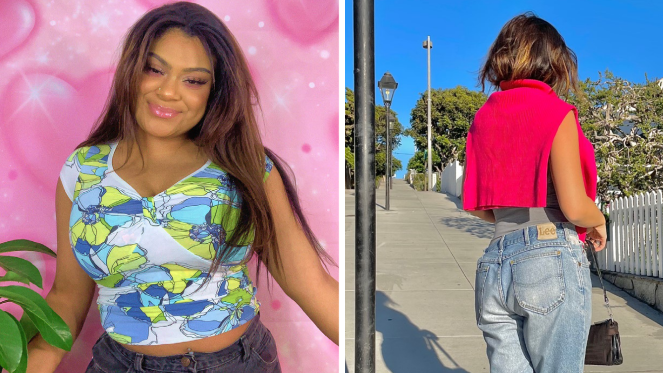Section Branding
Header Content
When Second Hand Becomes Vintage: Gen Z Has Made Thrifting A Big Business
Primary Content
When Eve Perez was in middle school, she remembers feeling embarrassed to shop at thrift stores. Surrounded by peers in name brands, Perez felt like there was a stigma associated with wearing used clothing.
Something shifted around five years ago, she recalls — right around the time the social networking platform Tumblr grew in popularity. She noticed a change in how people perceived buying and wearing used clothing. It became an edgy, countercultural thing to do.
Now, Perez, 21, makes upwards of $1000 each month by selling both handmade and second hand clothing on Depop, an online resale marketplace with a young user base.
"Thrifting has been normalized," Perez said, 21. "Since so many people are doing it, it's now seen as cooler. It's seen as better than going to the mall. Younger people find it fun, like a game. A hunt for something unique."
The increasing returns of that hunt has transformed thrifting into a viable, $28 billion industry that is expected to eclipse fast fashion by 2029, according to findings from ThredUp, an online consignment store. Second hand shopping is no longer just a local, community-driven hobby — it has wings.
Thrift Boom Boosted By Social Media Influencers
Accelerating these numbers is Generation Z, whose members have embraced second hand fashion faster than any other age group and account for over 40% of global consumers. The changing consumer habits and vast purchasing power of Gen Z are driving the value of resale startups like Depop skyward.
The app was acquired by craft marketplace Etsy in a $1.6 billion cash deal this month, a move designed to extend Etsy's reach into a younger and digitally-native audience. Depop was the perfect target. Designed to resemble a social media platform, 90% of the app's active users are under the age of 26.
The platform stands as a capsule of teen fashion in the digital age, where traditional retailers have become passe, trends are driven by social media influencers and argyle sweaters, lettuce-edged crop tops and Juicy Couture track suits from the early 2000s— qualify as vintage.
Teenagers driving the popularity of second hand fashion is a pattern that can be observed throughout history, says Jennifer Le Zotte, a historian and the author of "From Goodwill to Grunge."
Young people are generally more open to experimenting with styles and reinventing different versions of themselves, Le Zotte says. They want to distinguish themselves from the previous generation and to participate in creating those styles with their peers.
The allure of finding a vintage gem
And then there's the hunt. There is an allure in finding clothing that everyone else isn't wearing, says Becky Yoo, a 22-year-old publishing strategist from Los Angeles.
Shopping second hand is an accessible way to satisfy that urge, Yoo says. It can be cheap, too, but not always. Shopping on apps like Depop make it much easier to find a pair of perfectly-fitting vintage Levi's than by spending time sifting through racks at a thrift shop.
Not surprisingly, social media is driving the obsession. Influencers post massive thrift hauls on Instagram, TikTok and YouTube. That's where trends emerge, like bejeweled Harley Davidson crop tops, lace trim camisoles and the beloved low-rise jeans of the mid-2000s.
Sustainability a Gen Z shopping priority
Social media doesn't only promoting thrifting as a fashion statement, Yoo said. Platforms like Twitter and Instagram are filled with observations and information about the underbelly of the fast fashion industry, from landfill waste to exploitative working conditions.
"As I become more conscious of sustainability, it becomes a driving factor behind the way that I shop," Yoo says.
Environmental sustainability has become a significant priority influencing the shopping choices of young consumers, according to the 2019 State of Fashion report, a yearly report on trends within the global fashion industry.
The appeal of second hand shopping goes in cycles, Le Zotte says. It's impossible to know if the trend among young shoppers will persist, or if it will ever eclipse traditional retail. But its phenomenal growth caught traditional retailers off guard and has shifted the conversation about who sets trends and what qualifies as fashionable.
Copyright 2021 NPR. To see more, visit https://www.npr.org.


